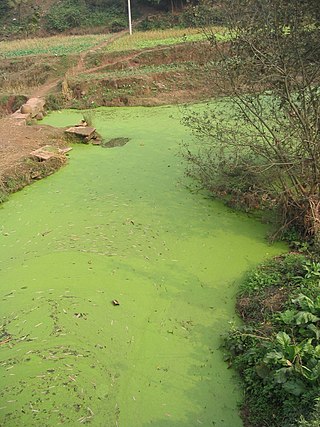
Eutrophication is a general term describing a process in which nutrients accumulate in a body of water, resulting in an increased growth of microorganisms that may deplete the oxygen of water. Eutrophication may occur naturally or as a result of human actions. Manmade, or cultural, eutrophication occurs when sewage, industrial wastewater, fertilizer runoff, and other nutrient sources are released into the environment. Such nutrient pollution usually causes algal blooms and bacterial growth, resulting in the depletion of dissolved oxygen in water and causing substantial environmental degradation.

The Nile perch, also known as the African snook, Goliath perch, African barramundi, Goliath barramundi, Giant lates or the Victoria perch, is a species of freshwater fish in family Latidae of order Perciformes. It is widespread throughout much of the Afrotropical realm, being native to the Congo, Nile, Senegal, Niger and Lake Chad, Volta, Lake Turkana, and other river basins. It also occurs in the brackish waters of Lake Maryut in Egypt. The Nile perch is a fish of substantial economic and food-security importance in East Africa. Originally described as Labrus niloticus, among the marine wrasses, the species has also been referred to as Centropomus niloticus. Common names include African snook, Victoria perch, and many local names in various African languages, such as the Luo name mbuta or mputa. In Tanzania, it is called sangara, sankara, or chenku. In Francophone African countries, it is known as capitaine. Its name in the Hausa language is giwan ruwa, meaning "water elephant".
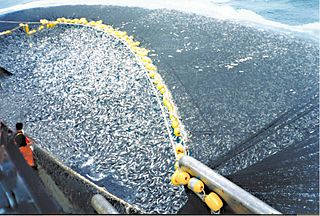
Overfishing is the removal of a species of fish from a body of water at a rate greater than that the species can replenish its population naturally, resulting in the species becoming increasingly underpopulated in that area. Overfishing can occur in water bodies of any sizes, such as ponds, wetlands, rivers, lakes or oceans, and can result in resource depletion, reduced biological growth rates and low biomass levels. Sustained overfishing can lead to critical depensation, where the fish population is no longer able to sustain itself. Some forms of overfishing, such as the overfishing of sharks, has led to the upset of entire marine ecosystems. Types of overfishing include growth overfishing, recruitment overfishing, and ecosystem overfishing. Overfishing not only causes negative impacts on biodiversity and ecosystem functioning, but also reduces fish production, which subsequently leads to negative social and economic consequences.

Lake Edward is one of the smaller African Great Lakes. It is located in the Albertine Rift, the western branch of the East African Rift, on the border between the Democratic Republic of the Congo (DRC) and Uganda, with its northern shore a few kilometres south of the equator.
Freshwater ecosystems are a subset of Earth's aquatic ecosystems that include the biological communities inhabiting freshwater waterbodies such as lakes, ponds, rivers, streams, springs, bogs, and wetlands. They can be contrasted with marine ecosystems, which have a much higher salinity. Freshwater habitats can be classified by different factors, including temperature, light penetration, nutrients, and vegetation.
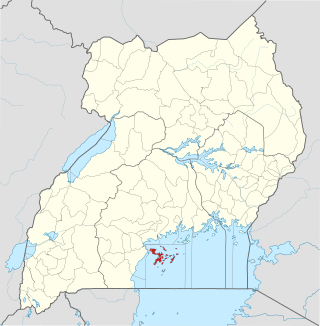
Kalangala, also known as Ssesse, is a district in Central Uganda. The district is coterminous with the Ssese Islands in Lake Victoria and does not have territory on mainland Uganda. Like other Ugandan districts, it is named after its 'chief town', Kalangala which is located on Bugala Island, the largest of the Ssese Islands.To reach Kalangala town on Bugala island one has to board a boat at specified points or use one of the Ferries sailing through the Bukakata-Luku route that joins the town with the mainland in Masaka District. There is also a relatively longer route that passes via Nakiwogo in Wakiso district to connect to Lutoboka on Bugala Island.
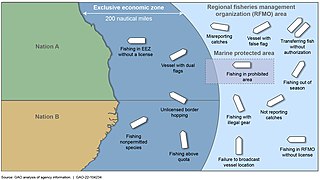
Illegal, unreported and unregulated fishing (IUU) is an issue around the world. Fishing industry observers believe IUU occurs in most fisheries, and accounts for up to 30% of total catches in some important fisheries.

Fish stocking is the practice of releasing fish that are artificially raised in a hatchery into a natural body of water, to supplement existing wild populations or to create a new population where previously none exists. Stocking may be done for the benefit of commercial, recreational or tribal heritage fishing, but may also be done for ecological conservation to restore or increase the population of threatened/endangered fish species that is pressured by prior overfishing, habitat destruction, and/or competition from invasive species.

There are two major sources of fish in Uganda; one is from aquaculture, the other from fishing in rivers and lakes. The latter has made up the largest and most significant share of all fishing. Open water covers 15.3 percent of Uganda's surface and comprises five major lakes which are the main sources of fish in the country. Lake Victoria continues to be the most important water body in Uganda both in size and contribution to the total fish catch, followed by Lake Albert and Lake Kyoga.
This is a glossary of terms used in fisheries, fisheries management and fisheries science.
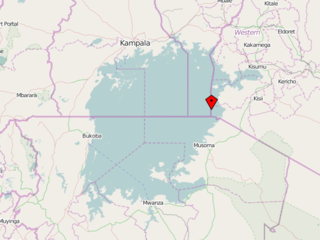
Migingo is a 2,000-square-metre island in Kenya on Lake Victoria. The island was the center of a low-level territorial dispute between Kenya and Uganda and is extremely densely populated. Migingo is a source of fish to the Kenyan and Ugandan fishermen.

Lake Wamala is a freshwater lake in Uganda. Its wetlands contain endangered species of birds and animals including the sitatunga. The lake is of traditional and cultural significance to the people of Buganda in Central Uganda.
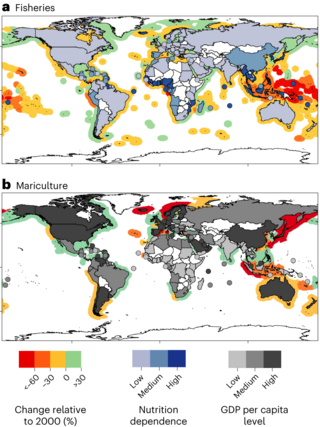
Fisheries are affected by climate change in many ways: marine aquatic ecosystems are being affected by rising ocean temperatures, ocean acidification and ocean deoxygenation, while freshwater ecosystems are being impacted by changes in water temperature, water flow, and fish habitat loss. These effects vary in the context of each fishery. Climate change is modifying fish distributions and the productivity of marine and freshwater species. Climate change is expected to lead to significant changes in the availability and trade of fish products. The geopolitical and economic consequences will be significant, especially for the countries most dependent on the sector. The biggest decreases in maximum catch potential can be expected in the tropics, mostly in the South Pacific regions.

Organisms targeted by NISA are categorized as aquatic nuisance species, including in particular zebra mussels and Eurasian ruffe. To extend upon NANPCA, NISA authorizes regulation of ballast water, a key factor in the spread of aquatic invasive species; funding for prevention and control research; regional involvement with the Aquatic Nuisance Species Task Force; and education and technical assistance programs to promote compliance with the new regulations. NISA also includes specific actions for certain geographical locations, such as the Great Lakes, Chesapeake Bay, the Gulf of Mexico, and San Francisco Bay.
Fishing sites and villages/communities in Uganda are mostly on islands and at landing sites. These act as central points for fish trade and fishing.
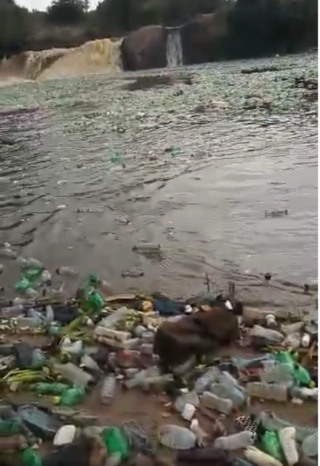
River Rwizi is a river located in South Western Uganda in district called Mbarara. River Rwizi is a river located in southwestern Uganda. It is the second-longest river in Uganda, after the Nile River. The river originates in the hills of Buhweju District and flows through the districts of Sheema, Bushenyi, Ntungamo, Rwampara, Mbarara, Isingiro, Kiruhura, Lyantonde, Rakai, and Kyotera. It eventually empties into Lake Victoria. Many swamps feed river Rwizi, including Nyakafumura, part of the Mushasha water basin, and Kanyabukanja wetland. These marshes function as water reservoirs or catchments, gently releasing water into the river to support the surrounding population.

Kasensero landing site is a fishing port found on Lake Victoria, in the Rakai District of Central Uganda, a short distance from its border with Tanzania. Kasensero is used as a centre for fish trade in Uganda. The community has a population of approximately 15,000 inhabitants.
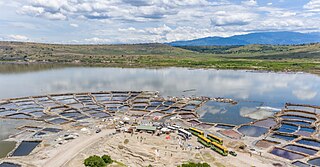
Lake Katwe is a hypersaline lake located in the district of Kasese, southwestern Uganda. It is renowned for its high salt concentration and has a rich history of salt mining by local communities.

Lake Mburo is a freshwater lake located in western Uganda, situated within the Lake Mburo National Park. It is a prominent feature of the region, known for its scenic beauty and rich biodiversity.

Lake Kachera is also known as Lake Kachira, Lake Kacheera, Lake Kakyera and Lake Kachra is a shallow fresh water lake that is located in Rakai district and Mbarara district in Uganda. It is a part of the Mburo-Nakivale wetland system and also a part of the complex system of lakes known as Koki lakes that are separated by vast swamps. It is also one of the lakes that make the Victoria satellite lakes.


















